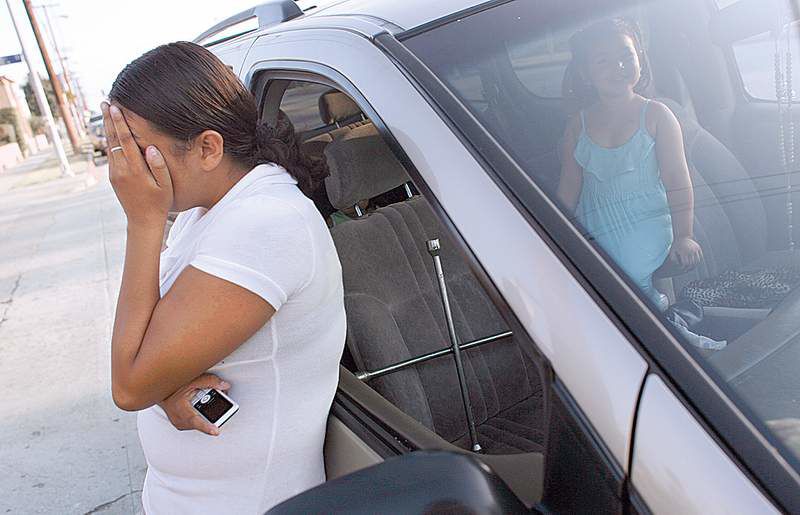Gang feud, begun over a girl, unsettles south Los Angeles
Published 5:00 am Sunday, September 20, 2009

- A woman who asked not to be identified sobs in south Los Angeles after a man allegedly threw a beer bottle at her car, nearly breaking the window next to her daughter, right.
LOS ANGELES — It began, as mortal disputes sometimes do in south Los Angeles, over a girl.
On one side were the Main Street Crips, one of the more muscular gangs in the neighborhood. Main Streeters commanded respect, if only because they had a bit of money to throw around, even their own small record label. On the other side were the Hoover Criminals. The Hoovers were big, with turf that stretched from Vernon Avenue down past Century Boulevard and into “the hundreds,” as the streets are known locally. The Hoovers were belligerent, too; they seemed to have a hard time getting along with anybody — except the Main Street Crips.
Over the years, the two gangs had carved up one patch of south Los Angeles, settling on Broadway as their loose border — Main Street Crips to the east, Hoovers to the west. Partly because of old friendships, partly because their alliance was good for business, they had coexisted that way for as long as anyone could remember.
Then, one balmy night in August, Main Street threw a party. The Hoovers were invited. The details are murky — something about a girlfriend and a racy remark — but it doesn’t matter now. Guns were pulled. Shots were fired. And an old-fashioned beef, the likes of which this part of south Los Angeles hadn’t seen in several years, was under way.
Ominous dispute
There have been at least six shootings in the wake of that night. Three people are dead, including a seventh-grader, gunned down on Broadway after he’d gone to buy balloons at a swap meet.
Many residents, civic leaders and city officials believe south Los Angeles is at a crossroads in part because violent crime has fallen so sharply.
A reduction in gang violence has led the way. The LAPD’s Southeast Division, for instance — 10 square miles containing 66 gangs, and another district affected by the dispute — averaged about 140 homicides per year in the late 1980s and early ’90s, when violence peaked. Officials said they expect to finish 2009 somewhere in the 50s.
That’s why this dispute is so unsettling to police and local officials. It was once routine for gangs to duel openly, but that’s less common these days; relatively few shots are fired solely to retaliate for previous shootings. Worse, the Hoover-Main Street dispute is considered perhaps the most ominous aspect of a broader spike in killings across south Los Angeles this summer, police said.
In July and August, the police divisions that patrol most of south Los Angeles recorded 40 homicides, double the rate from the beginning of the year. On Aug. 25, Mayor Antonio Villaraigosa and Police Chief William Bratton announced that they had created a multi-agency task force to deal with the rise in violence.
Hours later, at 8 o’clock that night, a gunman walked into the heart of Main Street Crip territory, on Main Street itself, and shot Drayvon James, 29, and Robert Nelson, 16. The double homicide, which has not been solved, is considered one of the incidents that might be linked to the Hoover-Main Street dispute, police said.
Daquawn’s case
But it was the shooting death of 13-year-old Daquawn Allen that seems to have shaken the neighborhood to its core.
Daquawn’s shooting illustrates the complexities of policing the gangs of south Los Angeles.
He was not a gangbanger, according to police and his relatives. But he was born in Hoover Criminals territory, just west of Broadway. He never knew his father. When he was 9, his mother was sent to prison, and he moved in with his grandmother. Her house was just a few blocks away — but they were an important few blocks, on the other side of Broadway.
Daquawn had an easy, impish smile and was well-liked. In private, he was terribly upset that he had never met his father, said his grandmother, 54-year-old Linda Allen. He was desperate for male attention, she said, and he found it to some degree with a “set” of Hoovers — part of the larger gang — called the 94 Hoovers, sometimes spelled “9-Foe” and named after West 94th Street.
They even gave Daquawn a street name: Four Star.
Linda Allen refused to use it. “I told him: ‘You use the name your momma gave you,’” she said recently on the porch of her home.
To Daquawn, the Hoovers weren’t a criminal enterprise but a social network, a brotherhood, Allen said. She pulled with all her might in the other direction. “But kids don’t listen,” she said. “They think they know more than you.”
On Aug. 16, the day after the squabble at the party, Daquawn walked with a friend to a swap meet. On their way home, at 12:20 in the afternoon, in front of a hair salon and a cell phone shop on Broadway, a gunman shot Daquawn twice in the torso with a semiautomatic pistol. Allen heard the shots from her living room.
She said she knows the public might lump Daquawn in with the gang, might see him as no different from the gang’s active criminals.
“People say: ‘Well, he got what he deserved.’ But this is family to me. And it hurts,” she said. “This is the worst it’s been for a long time.”






